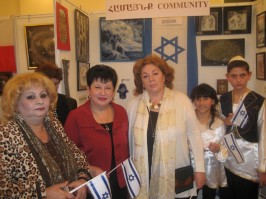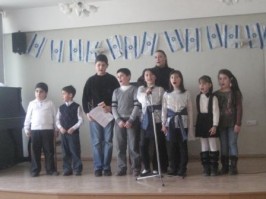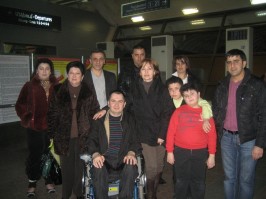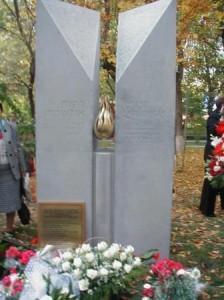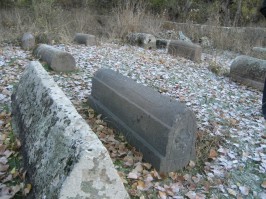Anecdotal reports indicate that Jews appeared in the territory of Armenia after the conquest of Jerusalem by the Babylonian king Nebuchadnezzar II in 586 BC. Jewish groups were relocated to Armenia from Palestine in the first century BC by Kings Tigran II and Artavazd. However, in the fourth century AD, after the defeat of Armenia by Persian forces, the majority of Jews were taken into captivity. Some isolated groups of Jews remained in Armenia until the thirteenth and fourteenth centuries. The descendants of the so-called “Tigranovie'” Jews are referred to as the “zoks.” And are a sub-ethnic group of Armenians living in the Kapan region.
In the nineteenth century, after the territory of Armenia was joined to the Russian Empire according to the agreement of Turkmanchai in 1828, Georgian and Ashkenazi Jews arrived, as well as Sabbatarians, Russian peasants who accepted Judaism and were banished to the outskirts of the new empire. By 1970 the Jewish population in Armenia numbered 1,048 people. At the end of 1980, this number (including the Sabbatarians) increased to about 3,000 people.
In the 1990s a large portion of Armenian Jews, about 1,800 people, left Armenia… Currently, in Armenia there are about 700 Jews. Despite the fact that annually 90-100 people emigrate, the community has not diminished. The main Jewish organization of the republic is the above-mentioned Jewish Community of Armenia in Yerevan. Since 1996, it has been chaired by Rima Varzhapetyan-Feller. She is also a member of the General Council EAJC (Euro-Asian Jewish Congress), the Continental section WCRJ (World Congress of Russian Jewry), and the Council and Coordination Council and Public Council under the President of the Republic of Armenia. Rima Varzhapetyan-Feller also serves on the panel of national Human Rights Defenders.
With the support of EAJC, the Community has published a newspaper, “Magen David,” since 2002. Adelina Livshits became the chief editor of the paper in August 2009. In 2004 the website www.jewish.am was launched.
The community has a children’s vocal ensemble, “Keshet”, a Sunday school and the Ulpan, as well as the Israeli Cultural Center, whose director is Georgi Fayvush, an academician and doctor of biological sciences.
A small group of Jews lives in the city of Vanadzor. In addition, in Sevan, formerly in the village Yelenovka, there is a community of Sabbatarians. Most of its members fled from Armenia in 1990. For many years, the Sevan, Vanadzor and Yerevan communities received regular humanitarian aid, medicine, food parcels and money to pay for electricity from the Jewish Community of Armenia, which, in its turn, was supported by Jewish organizations in America was very difficult because of the global crisis, and to date no assistance from the United States is received.
In Yerevan, operates the only synagogue in the country (its rabbi is the Chief Rabbi of Armenia, Gersh Meir Burshtein).
With the assistance of EAJC every year matzah was brought to Armenia from the Ukraine. The Jewish community is working closely with the “HaSochnut”, arranging seminars, young people participating in programs of the Jewish Agency for Israel. In 2011, for the first time in the history of immigration from Armenia has been established direct flights Yerevan – Tel-Aviv. Until that time, the repatriation was carried out through Tbilisi.
In May 2008, Yerevan hosted celebrations dedicated to the 60th anniversary of the State of Israel. The solemn opening ceremony, the Avenue of Friendship between Armenia and Israel, “Keren Kaeemet le Israel”, was organized by EAJC and held in Victory Park on March 20, 2009. This official opening was attended by the General Secretary of the EAJC, Mikhail The Monument Devoted to the Victims of the Holocaust and the Genocide Chlenov, the mayor of Yerevan, representatives of the Office of the President of Armenia, the Ministry of Defense, and the Ministry of Culture and other officials. Armenian-Israeli relations have been complicated by the problem that the government of Israel does not recognize the Armenian massacres of 1915 as genocide.
Community members participate regularly in rallies dedicated to the victims of the genocide. The grand opening of the monument to the victims of the Armenian Genocide and the Holocaust, designed by artist Ruben Arutchyan, was held in Yerevan on October 27, 2006. The monument was commissioned by the Jewish Community of Armenia and personally of its chairman, Rimma Varzhapetyan-Feller. The Republican Party of Armenia, as well as the United States Commission on preservation of the heritage of America abroad and members of the community, supported the creation of the monument financially. On days of mourning, those who want to honor the memory of the innocent victims of the Genocide and the Holocaust gather around the monument. The monument is visited by diplomats, foreign officials and tourists.
Yerevan State University has a department of Hebraic studies. In 2003, a textbook, “Modern Hebrew” was published in the Armenian language.
In the district center of Armenia Yeghegnadzor, in the village of Yeghegis, a Jewish cemetery dating back to the eleventh through the thirteenth centuries has been discovered. The excavations were conducted by Dr. Michael Stone, professor and head of the Hebrew University of Jerusalem, as well as the head of Syunik Diocese, Bishop Abraham Mkrtchyan. Presently, restoration work in the excavation area has been completed. The cemetery has been restored with the help of funding from the Government of Armenia.
Yeghegis hosted a scientific symposium entitled “The Jewish Cemetery in the village of Yeghegis” on May 11 and 12, 2009, explaining the extent of the enormous scientific and restoration work which had been accomplished there. Based on the symposium materials, the Jewish community of Armenia, with the financial support from the U.S. Embassy in Armenia and the Ministry of Foreign Affairs of Israel, published the book “Jews in Armenia, Middle Ages.” Currently another book, “Jews in Armenian, Modernity” is set to be published. The opening of the Jewish Museum in the building of Yeghegnadzor History museum is scheduled for May 12, 2011.
The Jewish community of Armenia is implementing various projects aimed at strengthening friendship between Jewish and Armenian people. The Prime Minister of the Republic of Armenia awarded a medal for the development and strengthening of the Armenian-Jewish relations to the Chairperson of the Jewish Community of Armenia, Rimma Varzhapetyan-Feller, in 2009. In 2010, she was also awarded an honorary Diploma by the President of Armenia for her long-term and extensive work on the Coordinating Council of National Minorities of Armenia and for promoting intercommunity cooperation.

